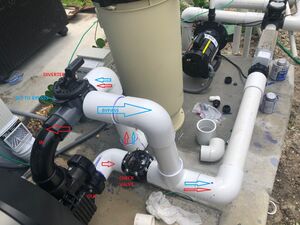Why a Heater Bypass Valve is a Good Thing to Have
Many pools have an expensive heater in their water flow. Water circulates through the heater core all the time the pump is running, whether the heater is on or off. If the heater springs a leak, you have to shutdown the pump, which stop waters circulation, filtering and chlorinating your pool. Having the pump stopped too long can lead to algae and a dirty pool, and more work once you get the heater repaired and the pump running again.
If you had a heater bypass valve, that switches the water flow to flow around the heater, you would just move it the bypass position and you can continue running the pump and circulating pool water normally while you get the heater repaired or replaced.
Most pool heater heat exchanger, which is a coil of pipe inside the heater, is made of copper. Low Ph, below 7.0 can cause the copper pipes to erode resulting in copper in the pool water and possibly leaks from the heat exchanger. Even if the copper erosion of the heat exchanger pipes is not serious enough to leak the copper in the pool water can cause stains in the pool.
With a relatively new pool or heater you may not see a leak for many years and wish you had a heater bypass valve. However you may encounter another situation where bypassing the heater is helpful. Heater cores can be damaged by acidic low pH below 7. Maybe you misjudged your acid addition and accidentally lowered your pH too much. If you have a heater bypass you can turn the valve and stop the acidic water from flowing through the heater. Or maybe you purposely lower the pH to around 7 to treat a scale problem. You can use the heater bypass valve to take the heater offline and protect the core.
Also, if you are in an area where you close your pool for the winter your water chemistry may need adjustments upon Spring opening and you may not be confident that your pH is stable while adding chemicals. You can bypass the heater and protect the copper core during the pool opening until your pH is stable between 7.2 and 7.8.
Water running through a heater all the time creates back pressure, slows the water flow, and makes the pump work harder running at higher RPMs using more energy. Especially if you have a heat pump which has smaller diameter internal piping then a gas heater. Some pool owners only use their heater 5% of the time, yet their water flow is restricted the 95% when the heater is not in use. Bypassing the heater during the hot summer months when it is not necessary can improve water circulation.
In summary, times the heater should be bypassed include when:
- the heater is leaking or needs repairs
- opening the pool in the Spring and balancing the water chemistry
- the pH may fall below 7.0
- using any algaecide that may lower the pH below 7.0
- the heater is not being used for periods of time
Some heaters have an internal bypass to control how much water flows through its core while bypassing the remaining water directly out the heater. Others heaters may have an external bypass to limit the flow to not exceed the heaters maximum flow rate. Neither of those is the same as the heater bypass being discussed here since they cannot stop water from flowing through the heater core.
For some unknown reasons many Pool Builders push back on the request to install a heater bypass. It is very simple requiring a 3 way diverter valve on the heater input line, a short length of PVC to connect to a T on the heater output line, and a check valve between the T and the heater output. In the picture above the red arrows show the water flow in normal heater operation and the blue arrows show the water flow when the heater is bypassed. The added cost and plumbing is minimal.
As described above there are many situations where a heater bypass is useful. Sooner or later in the life of the pool you will likely encounter one of them. And really there are no downsides in having the heater bypass line between the heater input and output pipes waiting for when you need it.


